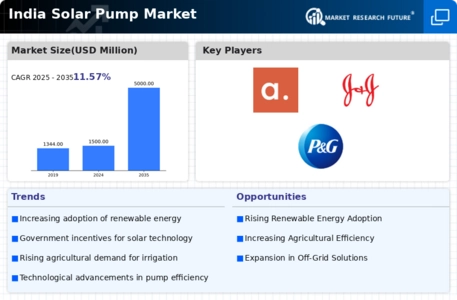Market Analysis
In-depth Analysis of India Solar Pump Market Industry Landscape
In the dynamic landscape of the India Solar Pump market, companies deploy strategic market share positioning strategies to navigate the rapidly growing renewable energy sector. A key strategy involves technological innovation and product differentiation. Companies invest in research and development to enhance the efficiency, reliability, and affordability of solar pump technologies. Innovations in photovoltaic cells, pump design, and energy storage systems contribute to a competitive edge, allowing companies to capture a significant market share by offering advanced and cost-effective solar pump solutions.
Strategic collaborations and partnerships are instrumental in market share positioning. Companies form alliances with solar technology providers, financial institutions, and government agencies to leverage combined expertise and resources. Such partnerships facilitate access to funding, technological know-how, and market insights. Joint ventures also enable companies to expand their reach, navigate regulatory challenges, and accelerate the deployment of solar pump projects, contributing to a stronger market share position.
Government policies and regulatory alignment are critical elements in market share positioning strategies within the India Solar Pump market. Companies strategically align themselves with government initiatives, subsidies, and incentives aimed at promoting solar energy adoption. Adherence to regulatory frameworks ensures compliance with national renewable energy targets, making companies more attractive to investors and customers. Strategic alignment with government policies enhances a company's market standing, supporting efforts to secure a substantial market share in India's solar pump industry.
Marketing and branding strategies play a pivotal role in market share positioning. Companies emphasize their commitment to sustainability, environmental responsibility, and energy efficiency in their marketing efforts. Establishing a strong brand identity as a reliable provider of solar pump solutions enhances customer trust and loyalty. Effective communication of environmental benefits and participation in corporate social responsibility initiatives further contribute to positive public perception, attracting a larger customer base and solidifying market share.
Efficient project execution and robust after-sales services are crucial market share positioning strategies. Companies streamline project development processes, ensuring timely and cost-effective implementation of solar pump projects. The ability to deliver turnkey solutions, including installation, maintenance, and support services, enhances customer satisfaction and builds long-term relationships. Efficient project execution contributes to positive word-of-mouth referrals, supporting a company's reputation and market share growth.
Strategies focusing on affordability and financial accessibility are vital for market share positioning. Companies design flexible financing models, partnerships with financial institutions, and leasing options to make solar pump solutions more accessible to a broader customer base. By addressing financial barriers, companies can tap into new market segments, expand their customer reach, and secure a larger market share in India's diverse and decentralized agricultural landscape.
Technological integration with smart and digital solutions is becoming increasingly important for market share positioning. Companies invest in data analytics, remote monitoring, and IoT-enabled features to enhance the functionality and performance of solar pump systems. Smart solutions not only improve operational efficiency but also enable companies to offer innovative services, such as predictive maintenance and real-time performance monitoring, fostering a competitive advantage and strengthening market share.
Strategies that prioritize skill development and local capacity building contribute to market share positioning. Companies invest in training programs and partnerships with local communities to build a skilled workforce capable of installing, operating, and maintaining solar pump systems. By empowering local communities, companies enhance their social impact and create a positive reputation, contributing to a stronger market share position in the India Solar Pump market.
In conclusion, market share positioning strategies in the India Solar Pump market encompass a strategic and multifaceted approach. Technological innovation, strategic collaborations, alignment with government policies, effective marketing, efficient project execution, financial accessibility, technological integration, and local capacity building collectively contribute to a company's competitive positioning. As solar pumps play a pivotal role in addressing India's agricultural and water pumping needs, companies implementing effective strategies are well-positioned to capture significant market share and contribute to the country's sustainable and decentralized energy landscape.






Leave a Comment